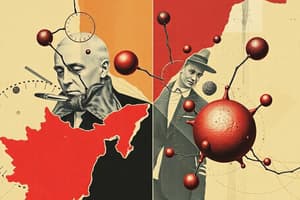Podcast
Questions and Answers
What is a chemical bond?
What is a chemical bond?
The force that holds two atoms together; may form by the attraction of a positive ion for a negative ion or by sharing electrons.
What is a cation?
What is a cation?
An ion that has a positive charge.
What is an anion?
What is an anion?
An ion that has a negative charge.
What is an ionic bond?
What is an ionic bond?
What is an ionic compound?
What is an ionic compound?
What is a crystal lattice?
What is a crystal lattice?
What is an electrolyte?
What is an electrolyte?
What is lattice energy?
What is lattice energy?
What is a formula unit?
What is a formula unit?
What is a monatomic ion?
What is a monatomic ion?
What is a polyatomic ion?
What is a polyatomic ion?
What is an oxyanion?
What is an oxyanion?
What does the electron sea model propose?
What does the electron sea model propose?
What is a metallic bond?
What is a metallic bond?
What is an alloy?
What is an alloy?
Flashcards are hidden until you start studying
Study Notes
Chemical Bonds
- A chemical bond is the force that holds two atoms together, formed by attraction between positive and negative ions or by sharing electrons.
Ions
- Cations are positively charged ions.
- Anions are negatively charged ions.
Ionic Bonds and Compounds
- An ionic bond is the electrostatic force that cohesively holds oppositely charged particles in an ionic compound.
- An ionic compound consists of ionic bonds and contains ordered arrangements of cations and anions.
Crystal Lattice Structure
- A crystal lattice is a three-dimensional geometric arrangement where each positive ion is surrounded by negative ions and vice versa, with shapes varying based on ion sizes and amounts.
Electrolytes and Solutions
- Electrolytes are ionic compounds that, when dissolved in water, conduct electric currents due to their dissociated ions.
Lattice Energy
- Lattice energy is the energy needed to separate one mole of ionic compound ions, influenced by the size and charge of the ions involved.
Formula Unit
- A formula unit represents the simplest ratio of ions in an ionic compound, symbolizing the proportions of different ions present.
Types of Ions
- Monatomic ions consist of a single atom, while polyatomic ions comprise two or more atoms bonded together, functioning as a single entity with a net charge.
- Oxyanions are a type of polyatomic ion consisting of a nonmetal element bonded to one or more oxygen atoms.
Electron Sea Model
- The electron sea model describes metallic solids where valence electrons from metal atoms form a 'sea' of delocalized electrons, explaining properties like malleability and electrical conductivity.
Metallic Bonds
- Metallic bonds are formed by the attraction between metallic cations and delocalized electrons, allowing movement and bonding in metallic structures.
Alloys
- Alloys are mixtures of elements exhibiting metallic properties, either as substitutional (similar-sized elements) or interstitial (smaller atoms fitting between larger ones) alloys.
Studying That Suits You
Use AI to generate personalized quizzes and flashcards to suit your learning preferences.




